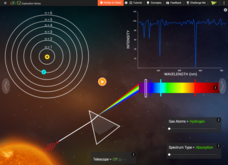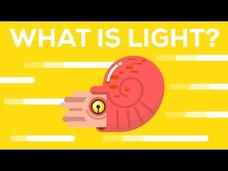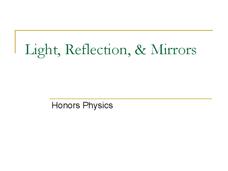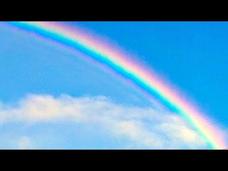Electromagnetic Spectrum Teacher Resources
Find Electromagnetic Spectrum lesson plans and worksheets
Showing 402 resources
CK-12 Foundation
Atomic Colors
Stars are too hot to visit, so how do we know what different stars are made of? An enlightening simulation uses a spectrum graph to show the various electron emission and absorption reactions. Scholars experiment with both helium and...
Kurzgesagt – In a Nutshell
What Is Light?
Why is light like the Navy? Because they both travel at c. The video explains what light is and what makes visible light different from the rest of the light spectrum. Scholars finish the video enLIGHTened about the concept.
PBS
Visible Light | UNC-TV Science
Shine a little light on the topic of visible light with a quick video lesson. The lesson highlights the basics of visible light including wavelength and electromagnetic energy. Learners discover how humans' eyes process the...
PBS
Blow the Roof Off!
Blow the minds of young scientists with this collection of inquiry-based investigations. Based on a series of eight videos, these "hands-on, minds-on" science lessons engage young learners in exploring a wide range of topics...
Bozeman Science
Light
Colors, a variation of the wavelength of light they emit, is the focus of a video that explains the different frequencies of light waves, models how our brain processes the electromagnetic radiation, and how we perceive light.
Veritasium
The Original Double Slit Experiment
Is light a wave or a particle? The video recreates the double slit experiment with sunlight in public. Different individuals predict what they will see by looking into a dark box, which allows sunlight into it through two small slits....
DoodleScience
Nuclear Radiation
Viewers learn about both natural and synthetic radiation in a video that discusses background radiation from cosmic rays, as well as from radioactive waste, radioactive fallout, and x-rays. It concludes with an explanation of alpha,...
Bowels Physics
Light, Reflection, and Mirrors
Explore the connection of light, reflection, and mirrors. A comprehensive lesson introduces the basics of light in relation to reflection and mirrors. After an explanation of the vocabulary, the presentation shows how to create ray...
Kurzgesagt – In a Nutshell
Death From Space—Gamma-Ray Bursts Explained
A gamma-ray burst might have caused the mass extinction 450 million years ago. The video introduces the concept of gamma rays and gamma-ray bursts. Then it explains what happens if they were to hit Earth and why we can't prepare for any...
American Chemical Society
The World's Most Unavoidable Carcinogen
Bask in the glow of an illuminating resource. Young scientists learn how sunlight is an ubiquitous carcinogen. The engaging video in the ACS Reactions series describes the effects ultraviolet radiation has on the human body.
Physics Girl
How Rainbows Form
Somewhere over the rainbow ... the sky appears to be darker than below it? Why is that? A video from an interesting physics playlist illustrates the interaction between the visible spectrum and droplets of rain. It also doubles the...
Physics Girl
What Is Dark Matter? A Mystery of the Universe
If you can't see something, how do you know it's there? Welcome to the mystery of dark matter! Curious cosmologists explore one of physics' longest-running quandaries through an interesting video. Content includes who first proposed the...
Teach Engineering
Designing a Spectroscopy Mission
In this mind-bending activity, young engineers explore this question of whether or not light actually bends. Using holographic diffraction gratings, groups design and build a spectrograph. The groups then move on research a problem...
Be Smart
Making Music From Space!
We know that sound cannot be heard in space, but can space make sound? Artists use various techniques to turn radiation waves, the earth's magnetic field, and other scientific data into music. This is the 20th video in a series of 22.
Curated OER
Light and Geometric Optics
It's time to see the light with a unit that focuses on light and geometric optics, including concave and convex mirrors. A variety of experiments, worksheets, and online activities are included.
Discovery Education
It's Getting Hot in Here
Class members engage in a STEM experiment and investigate how materials affect heating in a house by creating models of houses and using different top surface materials. They record the temperature inside the models and consider what the...
MinutePhysics
Why Isn't The Sky Purple?
We've all heard the tale about why the sky is blue. But, why aren't there stories about why the sky isn't purple? Or indigo? Science scholars explore the properties of visible light in a brief video. The narrator explains polychromatic...
Crash Course
Brown Dwarfs
Not quite a star, not quite a planet ... what are brown dwarfs? Young astronomers learn the peculiarities of these heavenly bodies through a short video. The narrator explains the characteristics of brown dwarfs and the different types....
Crash Course
A Brief History of the Universe
No one was actually there to see the birth of the universe, but years of collaboration between physicists and mathematicians allow us to glimpse all but a fraction of a second of it. A narrated journey shows the phase changes...
Towson University
The Crucial Concentration
Which sports drink provides the best pick-me-up after the big game or grueling workout? It may not be the one you'd think! Food science is the focus in a surprising lab activity. Pupils use colorimetry to determine the amount of protein,...
Royal Society of Chemistry
Colour—Gifted and Talented Chemistry
Add a splash of color to your chemistry class! Science scholars discover the principles behind color through a wide variety of hands-on activities. Lessons include dyes, chromatography, and flame tests.
PBS
Solar Space Telescopes
See the sun shine as you've never seen it before! Captivate your class with an activity from NOVA's Sun Lab unit. Viewers learn about the advanced satellite-mounted telescopes NASA uses to monitor the sun at every wavelength of light,...
American Museum of Natural History
See the Light
It's time to see the light! Scholars perform three different experiments with light to reveal properties using a great remote learning resource. The pupils see how light reflects from a surface and refracts through different materials....
University of Colorado
Marvelous Martian Mineralogy
All you need is light. Groups use a reflectometer to find the reflectivity of specific chemical compounds. Learners compare the graphs of the reflectivity of the known compounds to Martian soil. Using the graph comparisons, scholars...

























